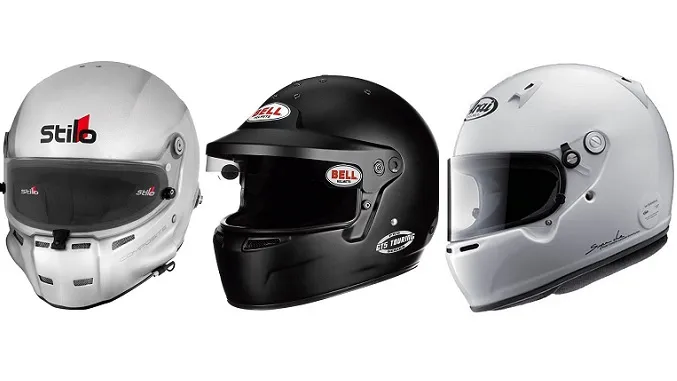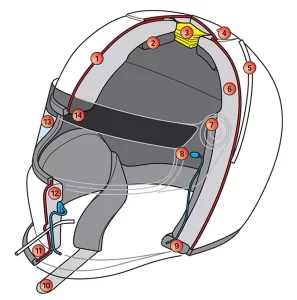7 min read
SNELL and FIA Homologation explained.

I am using current requirements from sanctioned racing groups, so details may vary by region or country.
Firstly, what is homologation? In motorsport, homologation is the approval process required for a vehicle, track, or standardized part to be certified for racing in a specific league or series. This testing and certification process for technical standards is commonly known as type approval in most jurisdictions. The regulations and rules to be met are set by the series’ sanctioning body. In this context, we will focus on the FIA and SNELL standards. SFI homologation will be discussed later.
In the United States, SNELL is the standard accepted by most sanctioning groups. If you plan on racing in any international series, an FIA homologated helmet will be required, even within the United States. Be sure to check with the event organizers to verify the specific helmet standard needed.
SNELL
SNELL updates its standards every five calendar years. Most US sanctioning bodies accept helmets from the current generation (SA2020) and the previous generation. However, this is not always the case, so it’s important to verify the specific requirements.
FIA
The FIA has two standard homologations: 8859 (standard) and 8860 (increased protection), each with specific implementation dates. Unlike SNELL, the FIA does not update its standards every five years but does so when necessary. The FIA 8860-2018 ABO (advanced ballistic protection) is the current and most rigorous homologation. The FIA 8859-2015 standard was last updated on April 10, 2019, and is accepted internationally. An 8860-2018 ABO helmet is only necessary for open-wheel, rally, and high-level endurance racing. Be sure to confirm the requirements with the event organizers.
Into the fray…
Your Budget
Many established helmet brands, such as Arai, Bell, Schubert, OMP, and Stilo, offer introductory helmets priced below $400. These competitive prices are typically due to four factors:
- Outsourced Manufacturing: Production is often outsourced to reduce costs.
- Basic Design and Materials: These models lack state-of-the-art innovations and exotic materials. They are generally heavier because the shells are made using standard manufacturing technologies with layers of fiberglass and resin instead of compression molding.
- General Designs: The designs are broad to appeal to a wide customer base, leading to compromises and a lack of specific features that some drivers, especially auto racers, might need.
- Comfort and Fit: Sizing is often limited and less precise. Cost savings are evident in the interiors, which use harder foams, coarser fabrics, and less attention to detail.
As your budget for a helmet increases, so do your options for more advanced features and higher quality.
The makeup of an auto racing helmet

A STRONG OUTER SHELL (1)
The preferred material for a helmet’s outer shell is carbon fiber or a composite material that includes Kevlar and/or carbon fiber. Carbon fiber is favored due to its strength and light weight, as well as its superior impact response. The shell can flex to dissipate energy, reducing the likelihood of cracking or splitting and protecting the interior foam from damage. Top racing helmets use high tensile carbon, which is even lighter and stronger.
INCREASED ENERGY ABSORBING FOAM (6)
State-of-the-art crush-resistant foam is essential for energy absorption. Manufacturers like Arai use multiple density foam fused together, with each section designed to absorb different load forces effectively.
HELMET REMOVAL SYSTEM (3)
Required by professional series such as IndyCar and IMSA, the Helmet Removal System (HRS) is recommended for all drivers. This system inflates a small rubber ball, helping first responders gently lift the helmet off a driver’s head in emergencies, reducing the risk of secondary neck or spine injuries.
ADDITIONAL AERODYNAMIC FEATURES (4) (5) (11)
For increased performance, reduced interior noise, and enhanced energy management, helmets may include features like duckbills, rear spoilers, chin bars, and top gurneys. These can be integrated into the shell design or attached with strong adhesive for easy replacement.
EFFECTIVE VENTILATION INTAKE SYSTEM (12)
Ventilation systems vary depending on the type of racing. Open cockpit drivers, for instance, avoid large front ventilation grills or side insert pods, which can disrupt airflow. Cooling systems in cars will pump air through top or side scoops.
INTERIOR INTEGRATED CHANNELS & CUT-OUTS (8)
Top brands like STILO offer helmets with integrated channels and cut-outs for seamless installation of electronics, earpieces, microphones, and drink tubes.
PRECISE FIT & COMFORT (9)
Achieving precise fit and comfort involves an accurate multiple size range and a sophisticated interior fit-pad that includes the neck and eye-port surround.
EYE-PORT & VISORS (14) (13) (7)
A narrow eye-port is crucial for racers, who should not need to move their heads significantly for track awareness. Visors, which have their own engraved FIA or SNELL tags, are available in various tints (light, medium, dark, and amber for night racing). Open cockpit drivers also use visor “tear-offs” to maintain clear vision.

Time to track
In the United States, amateur racers and track-day participants must have at least a SNELL or SFI homologated helmet, with SNELL being the most widely accepted standard. SNELL operates as a strict, independent regulator, requiring manufacturers to submit their helmets for testing and certification. In contrast, SFI issues safety criteria for manufacturers to meet but does not perform the testing themselves.
Most requested features :
A WIDER AND TALLER EYE-PORT
Track day participants rarely have their cars configured for racing, so they benefit from a wider and taller eye-port that provides better track vision and a safer, more open feel. Racing helmets can also feel very claustrophobic, especially for beginners, so this increased visibility helps alleviate that discomfort.
LESS WEIGHT
The weight difference between budget helmets and their more expensive counterparts is significant. For AutoX and HPDE (High Performance Driver Education) students, whose sessions last 20-30 minutes with breaks in between, weight is less critical. However, for advanced drivers and endurance racers, helmet weight becomes a major consideration.
Major brands use advanced technology and expensive materials like Kevlar and carbon fiber to reduce helmet weight. Composite helmets, especially those made of carbon fiber, are not only lighter but also stronger. This increased strength allows manufacturers to use less dense interior energy-absorbing foam, further reducing weight and enhancing comfort. Additionally, carbon fiber helmets are more resistant to damage such as scratches and chips.
SOFT AND THICK INTERIOR FIT-PAD FOAM INSERTS
The quality and comfort of the interior fit-pad foam is a key difference between budget and more expensive helmets. Think of it as choosing between a bargain mattress and memory foam. Higher-end helmets typically feature removable, exchangeable, and washable interior foam fit-pads, which are essential for maintaining hygiene and comfort.
VISORS
Visors are specific to each helmet brand and model. Most helmets come with clear and tinted visors, which can be exchanged for a variety of finishes and tints. The best visors offer a double screen, providing increased strength and excellent anti-fogging capabilities.
Helmet Fitting
Helmet fit is crucial to a successful day at the track. A helmet that does not fit will become a distraction. Driving distractions are dangerous and they also impede performance.
Unfortunately, measuring your head for a good fit is never that simple. One size does not fit all, even if you placed that tape measure correctly.
Look at the profiles, the same brands have different profiles for different models, some helmets are specifically altered for open cockpit driving.
It’s all in the fit.
Avoid pressure points
Especially those on the skull’s temple, forehead and sometimes the top of the head. This is where the head comes in contact with the ‘crush-zone’ foam. If you are feeling pressure at these points, go up a size of try another model, since the problem will only persist and probably get worse.
Observe your cheeks
A good fit has your cheeks semi-squashed but not so you are biting the inside of your cheeks. The inner layer of foam (fit-pads) of a helmet are always covered in a fire-retardant fabric . These fit-foam pads are not an integral to the helmet’s safety impact features. They exist to create a good and comfortable fit by filling the gaps between your head and the more dense ‘crush-zone’ foam. Tightness here is OK — this foam will soften with repeated use.
Your head should not be moving independently to your helmet
You do not need to shake your head repeatedly or violently when trying on a helmet. Use a quick movement side-to-side and up-and-down — replicating how your head would move inside the car. If your head and helmet are not moving together — the helmet is too large.
Have the helmet positioned correctly
If you can see the shadow of the foam above the eye port by just lifting your eyes — you have the correct position. Always check this before going on the track.
Remember the helmet increases your height.
Fitting you and your helmet in your car without touching the head liner (or worse) can be an issue. It is a frequent problem for drivers who are tall with older model sports cars, severe sloping roofs and/or compact cockpits.

